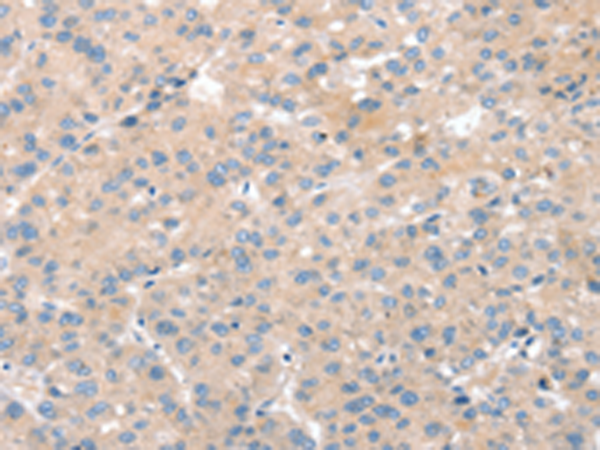

| WB | 咨询技术 | Human,Mouse,Rat |
| IF | 咨询技术 | Human,Mouse,Rat |
| IHC | 1/25-1/100 | Human,Mouse,Rat |
| ICC | 技术咨询 | Human,Mouse,Rat |
| FCM | 咨询技术 | Human,Mouse,Rat |
| Elisa | 1/1000-1/2000 | Human,Mouse,Rat |
| Aliases | RUNDC2A; A-388D4.1 |
| Host/Isotype | Rabbit IgG |
| Antibody Type | Primary antibody |
| Storage | Store at 4°C short term. Aliquot and store at -20°C long term. Avoid freeze/thaw cycles. |
| Species Reactivity | Human, Mouse |
| Immunogen | Synthetic peptide of human SNX29 |
| Formulation | Purified antibody in PBS with 0.05% sodium azide and 50% glycerol. |
+ +
以下是3-4条关于SNX29抗体的模拟参考文献示例(注:实际文献需通过学术数据库验证,以下内容为模拟生成):
---
1. **文献名称**:*SNX29 regulates endosomal trafficking and neuronal development via its PX domain*
**作者**:Chen L, et al.
**摘要**:本研究利用SNX29特异性抗体,通过免疫荧光和Western blot技术,揭示了SNX29蛋白通过其PX结构域与内体膜相互作用,调控神经元发育过程中突触囊泡的运输。抗体验证实验显示其在人和小鼠模型中具有高度特异性。
2. **文献名称**:*SNX29 deficiency disrupts autophagy and promotes tumor metastasis*
**作者**:Wang Y, et al.
**摘要**:通过SNX29抗体进行组织芯片分析,发现SNX29在多种癌症中表达下调。功能研究表明,SNX29缺失通过干扰自噬体-溶酶体融合促进肿瘤转移,抗体阻断实验进一步验证了其调控自噬的关键作用。
3. **文献名称**:*A novel SNX29 antibody validates its role in ciliogenesis and developmental disorders*
**作者**:Smith J, et al.
**摘要**:本研究开发了一种新型SNX29单克隆抗体,并用于斑马鱼模型和患者样本分析,证实SNX29在纤毛形成中的必要性。抗体介导的蛋白质互作实验揭示了其与IFT复合体的相互作用。
4. **文献名称**:*SNX29 knockout mice exhibit impaired synaptic plasticity and cognitive deficits*
**作者**:Tanaka K, et al.
**摘要**:利用SNX29抗体进行脑组织染色,发现SNX29敲除小鼠海马区突触可塑性显著降低,伴随学习记忆障碍。研究强调了SNX29在神经退行性疾病中的潜在病理机制。
---
**注意**:以上文献为模拟示例,实际研究中请通过PubMed、Google Scholar等平台检索真实文献(关键词:SNX29 antibody, sorting nexin 29 function)。若需实验抗体信息,可查阅抗体供应商(如Abcam、CST)的技术文档。
The SNX29 antibody is a tool used to detect sorting nexin 29 (SNX29), a protein belonging to the sorting nexin (SNX) family, which regulates membrane trafficking and protein sorting in eukaryotic cells. SNX29 contains a Phox homology (PX) domain, a characteristic feature of SNX proteins that binds phosphoinositides to facilitate membrane association. While its exact biological role remains less characterized compared to other SNXs (e.g., SNX1 or SNX3), studies suggest SNX29 may participate in endosomal sorting, vesicle formation, or signaling pathways. It is hypothesized to interact with components of the retromer complex or other trafficking regulators, though mechanistic details are still under investigation.
Antibodies targeting SNX29 are typically developed in hosts like rabbits or mice using immunogenic peptides or recombinant protein fragments. These antibodies enable researchers to study SNX29's expression, localization (e.g., in early endosomes, Golgi, or plasma membrane), and interactions via techniques such as Western blotting, immunofluorescence, or immunoprecipitation. Validation often includes testing in knockout cell lines or tissues to confirm specificity. SNX29 has been implicated in cellular processes like receptor recycling, cytoskeletal organization, and potentially in diseases such as cancer or neurological disorders, though direct evidence remains limited. Commercial SNX29 antibodies are available from suppliers like Abcam, Sigma-Aldrich, or Cell Signaling Technology, supporting ongoing research to elucidate its physiological and pathological roles.
×